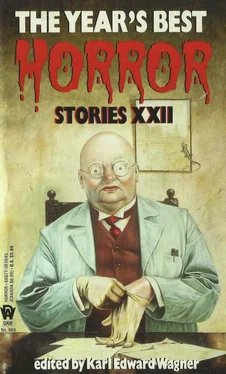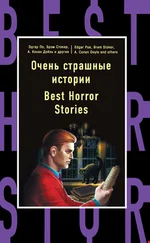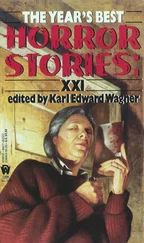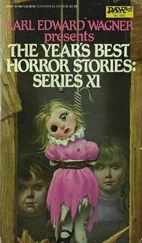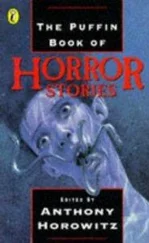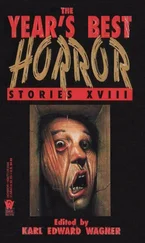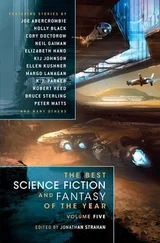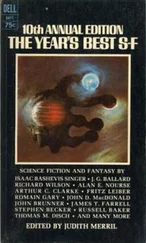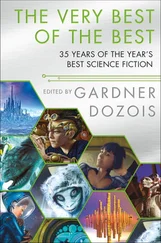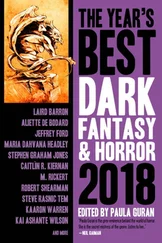THE YEAR’S BEST HORROR STORIES 22
Edited by Karl Edward Wagner
To Richard O’Brien
It’s just a jump to the left—
INTRODUCTION: BUT IS IT HORRIFIC?
So, then. What is a horror story?
You’re about to find out, inasmuch as you’re holding thirty-one of them in your hand right now.
The fact that you’ve picked up this book, The Year’s Best Horror Stones: XXII, would indicate that you are a fan of horror fiction or at least just curious. Could be that you have a complete set of signed Arkham House books (well…), or that you’ve just watched Halloween Nightmare on Friday the 13th for the sixth time and are torn between buying this book or another chainsaw. Regardless. Take this book home with you. Remember to pay for it; you don’t want thirty-one horror writers coming round for their missing commissions. That would be a horror story.
Which goes back to our question.
Not a new question, of course. Your dauntless editor has sat in on many panels and discussions where this question received the attention of lots of writers and editors. I’ve brought it up before in earlier volumes of The Year’s Best Horror Stories. Why bring it up again? Because the times they are a-changing. Perhaps.
Once upon a time horror stories were easy to categorize. Look for haunted ruins, creepy old houses, ghostly figures, bloodthirsty monsters, forbidden old tomes, eccentric scholars, teenagers misbehaving, teenagers dismembered—and a chainsaw-wielding vampire and a flesh-eating zombie or two, and you’ve got your genre defined from Gothic to gore.
Not that easy anymore.
This past autumn I showed one of my own stories to Stephen Jones and Ramsey Campbell, editors of the Best New Horror series. Steve commented that the story was good, but not horrific. Ramsey wrote back that it was “very powerful, not to say bleak,” and recommended it. As it turned out, they both agreed to reprint the story and I put down the sawed-off shotgun, but I found their reactions interesting. The story, “Passages,” was in part autobiographical and was nonfantasy. I found it horrifying, but I may have been too close. I wondered at their differing reactions. Obviously no two editors respond the same way to the same story. Otherwise all of the current year’s-best anthologies would have identical contents (when, in fact, there is virtually no overlap), and we’d all be bored.
Later, over a pint or two, Steve and I were comparing notes concerning the year’s catch in horror stories. I mentioned a story I meant to reprint here (It’s in here, but I forget which one—really!), and Steve said again that it was a good story but not horrific. All right by me, mate, since I’m competing for space in your book. But it got me wondering.
What is horror?
Lisa Tuttle, whose story, “Turning Thirty,” appears in this book, wrote back: “Well, of all the stories I thought might at some time be chosen for The Year’s Best Horror Stories, “Turning Thirty” was certainly not one. Not that I’m unaware of the horror implicit in the story, but…”
Again, nonfantasy—but when I described her story to science-fiction writer David Drake and to a knowledgeable woman fan of the genre, both of them shivered. Open-mouthed. Horrific?
Joel Lane, whose story, “Thicker Than Water,” also appears in this volume, observed regarding The Year’s Best Horror Stories: XXI from last year: “This seemed a more downbeat and atmospheric collection of stories than usual; I wondered if you had deliberately made it that way, or if that is simply the direction in which short horror fiction is heading.”
Right the second time, Joel.
After fifteen years as editor of The Year’s Best Horror Stories, I’m seeing a change in the wind. (Read a few thousand horror stories during the year, and you’re sure to start seeing things.) To wit:
The enormous proliferation of small press publications has fostered a whole new generation of horror writers.
Those writers who were good got better with experience; some of them now rank among the best in the horror genre.
The axis of horror is shifting with that maturity, and with that shift comes a new concept of horror fiction.
True. There are still tons of stories to be read each year about the never-learning massacred teenagers, the ever-flowing body fluids, the ever-hungry vampire/zombie/monsters, the ever-slashing serial killer. Some of these stories are damn good, and you’ll discover a few of them here. However, the same-old-same-old, if not in retreat, seems increasingly to be passed over by many writers in favor of exploring new and forbidding themes.
Once again. What is horror?
In trying to categorize the stories in The Year’s Best Horror Stories: XXII, your fearless editor is finally at a loss for words. Most of these defy definition. Some are straightforward straight-to-the-heart horror; many I can only warn you are strange and disturbing. Best label I can do.
Edward Bryant, in his review of last year’s The Year’s Best Horror Stories in Locus, remarked: “The spectrum of Wagner’s selections is tonally wide” and recommends the book for “the catholicism of the contents.” It would seem that Ed would agree that horror fiction is a much more diverse genre today than in the past. Maybe it’s turning mainstream. Maybe it’s a river running over its banks. A river of blood. A tide of fear.
Whatever your tastes and theories, slash or shiver, here are thirty-one of the best horror stories from 1993. As usual, over one-third of the authors here are appearing in the series for the first time. Growth and development. New voices. New definitions. New hands and new ways to twist the knife.
But is it horrific?
You’re about to find out.
Welcome to The Year’s Best Horror Stories: XXII.
—Karl Edward Wagner
Chapel Hill, North Carolina
THE RIPPER’S TUNE
by Gregory Nicoll
Born in Concord, New Hampshire on April 22, 1958, Gregory Nicoll has since settled down in Atlanta, Georgia, where he pursues his interests in Sam Peckinpah films, dark beer, hot chili, splatter films, rock music, and Volkswagens. Weird Mix. His fiction has appeared in numerous anthologies as well as in the small press, and he has written extensively for the film magazines, Fangoria and Gorezone. Nicoll also serves proudly as a charter member on the Foreign Films Committee of Joe Bob Briggs’ Drive-In Board of Experts.
In his last appearance in The Year’s Best Horror Stories , Nicoll had returned his contract with a photo of his beloved Volkswagen Rabbit pickup truck, badly damaged from a close encounter with a six-point whitetail buck. This year his contract came back with a photo of the same pickup, repaired in the interim and recently with a smashed fender. Writes Nicoll: “Do I have to crash that truck every year to get into your anthology? (I’ll do it till hell freezes over, or you say different.)” Wonder what he ran into this time.
“Well,” said Dark Annie, “what do you think of it, Liz?”
Long Liz ran her hand appreciatively up the length of the bass guitar’s neck. Its body was shaped like a screaming skull, the fretboard an extended arm. The peghead was a twisted skeletal hand, its irregularly spaced tuning pegs sculpted as heavy-gauge nails.
Читать дальше
